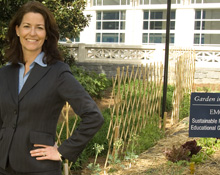People
April 12, 2010
First Person: Be the change

Ciannat Howett is director of sustainability initiatives.
When future generations look back, how will they judge us? For many of us, our daily activities include driving alone in a 4,000-pound metal shell, working miles away from where we live, eating out-of-season food shipped across the globe, and using drinking water to flush our toilets. We may follow this routine despite knowing that such a lifestyle is energy-consuming, greenhouse-gas-producing, wasteful and expensive. How can we address climate change when so many of our daily practices are out of tune with the limits of the natural world?
Part of the answer is technology, such as more energy-efficient commuting alternatives and water-saving devices such as dual-flush toilets. But technology is only as good as our willingness to use it. Currently, about 98 percent of federal funding to address climate change goes to research technologies aimed at reducing our dependence on fossil fuels. As important as that funding is, we also must invest in tackling the mindset that created climate change and motivating individuals and communities to embrace new behaviors. We cannot build or engineer our way out of this problem; climate change requires culture change. Many of the technologies for a more sustainable lifestyle are available and affordable, but key to their use is personal commitment.
Just as American universities are leading research into new technologies, they also have an important role in teaching life skills for sustainability. What does educating for a sustainable future look like? At Emory, it means an education inside and outside the classroom — for example, setting up systems that teach students to take public transportation, grow their own food, compost and recycle.
Academically, our aim is to integrate sustainability into the curriculum of all schools and departments — not just the natural and physical sciences. Emory has the longest-running faculty-development program in the country, the Piedmont Project, to encourage the use of nature as a classroom and the campus as a living laboratory.
For example, in a course co-taught in Rollins School of Public Health and the Emory College environmental studies department, students were asked to find a natural water source on campus and to calculate how much of their day they would need to set aside for hauling water just to meet their daily needs for drinking, bathing and food preparation. They then were asked to test the quality of the water to see if it was something that they really would want to use. This simple lesson is a life-changer. Students from a land of safe and accessible water are awakened to the realities and hardships of water scarcity for millions of people around the globe.
Everyday life on campus also can be a learning experience for our students. For example, students living in Few and Evans residence halls use collected rainwater pumped by solar energy from underground cisterns to dual-flush toilets. In this way, a new social norm is created. When these students become homeowners, they may consider a similar system for their homes. Over time, then, the carbon-intensive process of using huge volumes of drinking water to flush toilets may become a relic of bygone days.
Ideally, educating for a sustainable future begins early. Since 1992, Biology Professor Eloise Carter has taught k-12 teachers ways to integrate environmental education into their lesson plans and to develop their schoolyards into outdoor classrooms. It is impossible to measure the impact on a child of being taken outside — away from the confines of a desk — to feel the wind and sun on her skin and to see nature as having important lessons to teach. Perhaps it is time to enact a national policy of “No Child Left Inside.” Here at Emory, the doors are thrown fully open — for 60-year-old professors or 18-year-old first-year students.
Although Emory’s administration fully supports systems to foster a sustainable lifestyle and educate for a sustainable future, it is our students who are demanding many of the sustainability practices and programs now in place on campus. Increasingly, if you ask our students what jobs they want when they graduate, they will say green jobs. With a recent study by the Pew Charitable Trust showing jobs in America’s clean energy economy growing at two and a half times the rate of national job growth, green jobs are the future. Our students saw the generation before them spawn the information technology revolution out of a garage, and many of them believe that they can lead the post-petroleum revolution out of their dorm rooms. With their numbers and their passion, there is nothing to suggest that they cannot succeed. And these are students studying every discipline, not just science majors.
For example, Erik Fyfe was an environmental studies major who proposed that Emory’s buses run on biodiesel fuel using the waste cooking oil from campus dining halls. After graduation, he worked to produce biodiesel fuel for Emory and other clients. He created his own green job and improved our campus at the same time.
There are many more students like Erik — students committed to a sustainable future. When our students leave Emory’s gates, they are heading into a future that none of us can fully imagine. But this we know: they will be confronted with the most significant environmental challenge faced by any modern civilization. The greatest impact our universities can have on creating a brighter environmental future is by fostering a sustainable lifestyle in our graduates. If we engrain these practices, then when our students become parents, educators, business leaders, theologians, physicians and civic leaders, they will expect and demand sustainable practices. If we fulfill this responsibility, our children’s children will judge us from a clean, safe and sustainable world.
